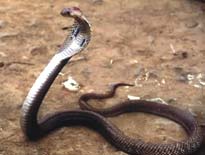Cobra, scientifically known as Naja naja, is one of the poisonous snake species native to the Indian subcontinent. It grows to an average height of 1 m and has two circular ocelli patterns on the rear of its hood. These patterns seem to be connected by a curved line, giving the look of spectacles. This is why the snake is also known as the Spectacled Cobra of India. A newborn cobra measures between 20 to 30 cm, but has fully functional venom glands.
Mating Behavior
Cobra snake lays its eggs during the period of April to July. The eggs, numbering between 12 and 30 eggs, are laid underground. The incubation period lasts for 48 to 69 days.
Diet
Spectacled Cobra of India survives on a diet consisting mainly of rodents.
Natural Habitat
Cobra is usually found inhabiting open forests and farmlands of India. However, one may also see them in Indian cities, living in the sewers and underground drains.
Relation with Indian Mythology
Cobra snake is widely associated with Indian Hindu mythology. Lord Shiva is often portrayed with a protective cobra coiled around his neck. Lord Vishnu is usually represented as resting on the coiled body of Sheshnag, a snake deity with a number of cobra heads.
Facts about Indian Cobra
Mating Behavior
Cobra snake lays its eggs during the period of April to July. The eggs, numbering between 12 and 30 eggs, are laid underground. The incubation period lasts for 48 to 69 days.
Diet
Spectacled Cobra of India survives on a diet consisting mainly of rodents.
Natural Habitat
Cobra is usually found inhabiting open forests and farmlands of India. However, one may also see them in Indian cities, living in the sewers and underground drains.
Relation with Indian Mythology
Cobra snake is widely associated with Indian Hindu mythology. Lord Shiva is often portrayed with a protective cobra coiled around his neck. Lord Vishnu is usually represented as resting on the coiled body of Sheshnag, a snake deity with a number of cobra heads.
Facts about Indian Cobra
| Kingdom : | Animalia |
| Scientific Name : | Naja naja |
| Class : | Reptilia |
| Order : | Squamata |
| Suborder : | Serpentes |
| Family : | Elapidae |
| Genus : | Naja |
| Species : | N. naja |
Diet and Nutrition
The preferred diet of the Cobra consists of a mixture of rodents and birds, yet they also eat other snakes. Some particular species, such as the King Cobra, are said to have a preference for other snakes. They kill their prey by injecting their neurotoxic poison into the prey through their fangs. The neurotoxin of a cobrasnake destroys the communication between nerve cells. When this communication is destroyed the victim's muscles cannot be used in any kind of defense.
Bite from a Cobra Snake
Not all cobra bites are venomous; some bites are so called dry bites which may cause serious infections due to bacteria from the cobras mouth. It is estimated that approximately 75 % of people receiving a bite from a cobrasnake will eventually die from the medical complications arising from the bite. A real (not dry) bite from a cobra snake will in the most severe cases cause death within 10 minutes.
Since its neurotoxic venom acts by inhibiting the transfer of transmitter substances across the synaptic cleft, mechanical ventilation of a victim may be a way of increasing the victim's chance of survival. If antivenin is necessary, it is of the upmost importance that the species of snake that caused the bite is correctly identified because the patient must be administered the correct antivenin and monitored properly (Britt & Burkhart 1997)2.
Habitat
Most Cobra snakes are found in desert regions of Africa and Asia.
Life Cycle
Some, but not all cobras, build small nests where the females lay their eggs. The number of laid eggs varies from season to season as well as other natural factors, such as the weather and the amount of available food. Approximately 9 weeks after mating, an average of 20 to 40 eggs are laid. New cobras emerge after two too two and a half months. The mother leaves the eggs, by instinct, just before they hatch. This is a smart trick from Mother Nature because else she will eat the eggs in most cases, even though it sounds like an illogical behavior. The baby cobra snakes are venomous right from the start and their lengths vary depending on the species.
King Cobra
The king cobra has a special preference for other snakes but it will also feed on small lizards and even mammals. It is found in Asia where it prefers to live in tropical forests and grassland. It is 10-12 feet long and will attack if provoked even though it is considered shy.
The king cobra snake can be found in India, southern parts of China, in the Philippines and in Malaysia. The snake occupies a wide range of habitats but prefers areas with access to water. It is, by the way, an excellent swimmer.
Spitting Cobra
Several species of the cobra snakes can spit. Spitting is used as a defence against predators. Generally a human can't die from cobra snake saliva only. The venom in the snake's saliva can however cause permanent blindness and give scars if untreated.
